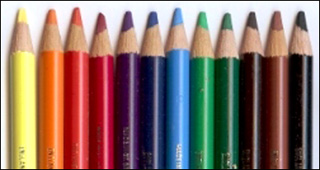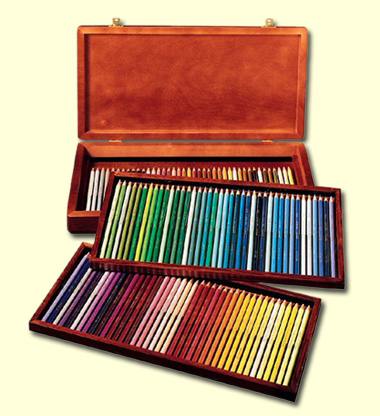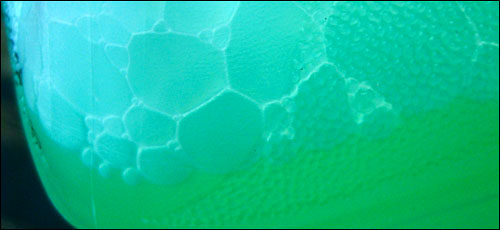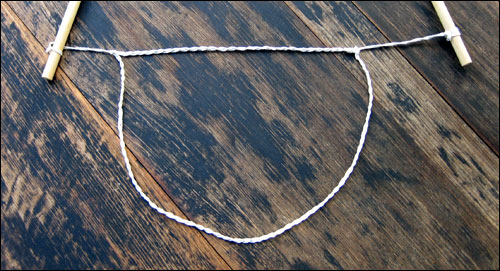Entries tagged with “Nostalgia”.
Did you find what you wanted?
Mon 10 Oct 2011

Since we’ve been speaking of apples, death and pancreatic cancer, here’s a photograph that my friend Adrienne sent me a couple of days ago. This is the Newton apple tree that I planted with the ashes of my beloved Kate, lovingly tended in its Blue Mountains home.
Fri 7 Oct 2011

I hate computers. I hate them in the same way as I hate audio equipment. For me, gadgets have always been a means to an end. My idea of the perfect audio system is one with no wires, no speakers, no knobs and no disks. All that stuff is ugly and distracting. I would be happy if I could just go into my favourite room and hear the music without any need for the accompanying paraphernalia.
And my idea of a perfect computer is one with no hard drives, no interfaces, no file systems, no processors. I don’t really care that something has 3 terabytes of RAM or a 16GHz processor. And the big humming boxes that house such things are ugly, distracting and hot. My idea of a perfect computing environment is one with nothing more than a screen, a sketchpad, and a keyboard ((I still like typing over writing, and for the short term at least I don’t see any alternative to a keyboard. When voice recognition becomes MUCH better, maybe it will be nice to speak things to your computer, but as long as we read, I think there will be writing of some kind. Perhaps that will change when direct neural interaction becomes possible…)) and where I can do stuff and get results without having to think about file management or disk fragmentation or syntax or communications protocols.
The last few days have seen a lot of discussion about the sad passing of Steve Jobs and the legacy he has left the world. There can be little doubt, even among the detractors, that his vision did change our modern lives in a most profound way. To deny it is to be trivially contrarian. For me, the greatest thing for which Steve ((It’s funny how I feel quite comfortable calling him Steve. In my circles it’s always been the way. I think he has been such a big influence in our daily lives that I feel, like a lot of people I guess, that I kinda knew him personally.)) is responsible is not the Mac, nor the iPod, the iPad or the iPhone, ((I’ve always detested that pretentious and irksome ‘i’ prefix…)) but the wondrous behind-the-scenes tech of the operating systems in all those gadgets.
Some of you are probably old enough to remember the kinds of computing devices that existed before the Apple Macintosh came along and changed the computing world forever. I had two of them: a Commodore 64 and an Atari ST. You communicated with the Commodore via BASIC ((The C64 had no operating system as such, hard as that is to comprehend these days. When you booted it, it was just a dumb blank brain until you loaded something into its RAM.)) and with the Atari via Atari DOS, neither of which were what you could remotely consider ‘intuitive’. Each of these devices required a significant amount of figurin’ if you wanted to get something useful done with them. There certainly wasn’t much need to own one unless you intended to do something that was, in those days, fairly obscure, like music sequencing or database building.
I believe that Steve Jobs greatest gift to us was to make the ‘computeriness’ of computers go away (well, at least to start making it go away – it’s still not as invisible yet as I would like personally). I think that Jobs understood in his bones that most people don’t have the remotest desire to want to tangle with computers. They just want to do stuff. They just want to have their whole music collection to choose from when they’re taking a walk. They just want a little game to play while they’re waiting for the train. They just want to snap pictures and send them to a friend – or make them into a photo album. They just want to be able to lie in bed and browse the web.
And, when they work, they just want to be able to write a letter, prepare a report, record a song, edit a movie or hold a video conference without having to understand what C+ or printer drivers or ROM or RAM or SCSI or serial ports are. Mr Jobs took us a long way along the path to never having to think about this kind of ephemera and to just getting on with doing the things we needed (and wanted) to do.
I admit, quite proudly, to being what is derogatorily known these days as an Apple fanboy. I bought my first Apple product, a Mac Plus, in 1988, and not long that after switched up to an SE. After the Atari it was like upgrading from a badly-tuned 2 cylinder motor scooter to a Rolls Royce. I was initially only interested in having a computer solely as a music tool, but with the Macintosh, suddenly I could do all this other stuff as well. It was truly an enlightening experience. The thing that captured my imagination most of all with those early Macs was that for my mind, at least, they just felt right. It was like there was someone sensible in the design process who was thinking more about me and how I might want to use the machine, than whether it had the latest chipset or the fastest clock speed. That someone was Steve Jobs. In short, I felt an immediate affinity with the Macintosh because it didn’t get in the way of what I wanted to do with it.
Advocates of PCs and the Microsoft Windows way of doing things (and to a lesser extent aficionados of worthy alternatives like Linux), can’t understand why we Apple disciples love our Apple environments so much. They look on the Apple culture as something like a fashion trend, believing us to have all been sucked in by the slick design and the tinker-toy simplicity of the computers themselves. They frequently proclaim that we have ‘drunk the Cool Aid’. What they fail to understand is that people like me simply don’t care that there are faster, cheaper, more efficient, cleverer ways to do computer things out there; ((Consider these two options: 1. An ugly car that has a theoretical speed of 300 mph, has a super-efficient engine, an optimized drive-train and is technically superior to every other car on the road – as long as you fully understood the complicated procedure for driving it; 2. A nicely designed car that reliably gets you to the shops and back without any thought on your part about how that’s achieved. Some people will undoubtedly choose the first option. People whose main concern is just getting the shopping done will be the same people who buy a Mac.)) to us, computers are necessary annoyances, and the simpler it is to get something done with them, and the less they force you to think ‘like a computer’, the better. ((In this respect, Apple’s ‘Think Different’ campaign is not so much about how people think about the world, but about how the world was thinking about computers. Apple was truly thinking different(ly).)) This was the critical insight of Steve Jobs – an insight that went on to inform the Apple music players, the phones, the tablets and the online stores. We love Apple, and we loved Steve, because he made our lives richer by giving us the power of computers without needing to be part of the arcane secret societies that had previously been the sole interlocutors for the mysterious digital magicks. This, I believe, is what the PC (and IT) crowd hate most about Apple – that it has given the peasants the keys to the church.
One of the criticisms you hear most from Apple critics is that Jobs pushed ‘style-over-substance’. This is mostly a cry of ‘How come we can’t make OUR things so neat?’, because if you think about it, how can anyone celebrate a lack of style? The real implication of this complaint is, of course, that if there is style there must necessarily be little substance. Such a deprecation indicates the profound absence of acumen of the prosaic mind. As any thinking person should realise, style is not just an outer layer in which something is cloaked, but is an integral part of its very being. To quote Jean-Luc Godard:
To me style is just the outside of content, and content the inside of style, like the outside and the inside of the human body. Both go together, they can’t be separated.
The style with which Jobs imbued Apple products is not surface deep, but reaches down into the core of the Apple brand. It is his personal philosophy that we engage with every day when we use our iPods and iPhones, our iPads and iMacs. We believe that Steve understood exactly how to allow us to engage with the world in a way that felt stylish and empowering and fun and, well, yes, insanely great.
It is for this reason, I believe, that even though we didn’t know him personally, many of us long-time and dedicated Apple users feel very deeply that with his untimely death we’ve lost a dear friend. And we fear that the people who are now taking over the reins at Apple might not truly understand what Steve Jobs seemed to embody intuitively as a driving force. Certainly, there is currently no-one else in the tech world who does, even including the very closely philosophically aligned Sergey Brin and Larry Page.
Perhaps that’s the way it happens. I guess that’s for history to judge. For now, Steve Jobs has planted the seeds of great ideas. We can only hope that they continue to grow into beautiful trees without him to tend them.
Rest in peace Steve. I, for one, am richer for having had my life illuminated by the tools and creative philosophies which you brought us.
Thu 30 Jun 2011

Or, How To Get Product Placement on Tetherd Cow Ahead Without Even Trying
A couple of weeks back I told you the story of the tragic event in my youth that undoubtedly thwarted a brilliant artistic career; namely the loss of my beautiful set of Derwent pencils. To my surprise, the charming Rebecca from Derwent in the UK read that post and kindly offered to send me some Derwents, which I’m pleased to report she did. They arrived in the post a few days ago.
The look of the pencils has changed somewhat – gone are the rainbow hues, replaced with an earthy brown with colourful tips (they’re not really blue like they appear in the arty HipstaMatic ((Dang. Secondary product placement! I should be getting kickbacks!)) shot above). I’m pleased to say, though, that the pencils themselves retain their waxy luxury and I aim to take a little outing somewhere over the next few weeks, to sit and draw, something I have not done in many years.
Wherever I venture, you can be sure that this time I will not leave my Derwents on the bus.
Thank you Rebecca, for the lovely coda to my childhood story.
Thu 2 Jun 2011
When I was a kid the most coveted material possession of school life was a set of Derwent Pencils. ((Yes, things were much simpler back then. Now, apparently, kids expect to have phones and computers and all manner of other expensive concessions and treat it all like it was simply their right. “All the other kids have [insert desired item].” It’s not an argument that ever held water when I was a child. Where on earth did this overbearing and irksome sense of entitlement come from?)) Derwents were the créme de la créme of primary school artistic tools – without Derwents, your chances of ever becoming a new Picasso or Rembrandt were vanishingly small. Derwents were, however, also quite expensive, and my family wasn’t well off, so for many years I had to make do with the much cheaper Faber Castells, and the fond hope that I could, if fate was on my side, aspire to the crazy heights of illustrating pamphlets for the ladies down at the Lilac City Festival offices.
Then, one sunny day – I don’t even think it was my birthday – my mum gave me a box of Derwents.

I was in Pencil Heaven. Just look at that chromatic spectacle of luscious luxurious pencilness! No more scratchy Fabers! Derwents spread their rich waxy hues across the paper like a rainbow rolling softly out over a coarse grey sky!
True, it was just a box of 12 Derwents – not even close to Charlie Peerbohm’s set of two million…

…but they were Derwents nonetheless, and they were mine. It goes without saying ((Just testing!)) that I took them to school the very next day, nonchalantly slipping them from my satchel and making sure I used them whenever an opportunity presented itself. I fancied that I caught envious stares from the kids still using Fabers, and I reveled in my new-found Pencil Czar status. Derwents of my very own! It was a happy day.
A short-lived happy day, as it turns out. I arrived home from school, still giddy from the day’s sheer brilliance, opened my bag… and with frightening suddenness an awful realisation closed in on me that somehow, somehow, I’d left my brand new box of Derwent pencils on the bus. Dammit! I even remembered taking them out of the bag and putting them on the bus seat. Why did I do that???! I was devastated. I ran to tell mum.
She looked at me with an expression that was completely inscrutable, and then did something that was unprecedented in my young life. My mother said:
“Oh well.”
And I knew instantly that I had irretrievably lost my Derwent pencils. That, as they say, was that. They weren’t coming back. I couldn’t blame my mum, she hadn’t lost them. And I knew it was completely unreasonable to expect her to get me another expensive set. I was angry. Not with her, but with myself. My pride was hurt and I felt cheated and powerless and stupid. And it was, indisputably, all my fault.
With the full understanding that I was very upset, my parents chose (wisely, I came to realise) not to simply buy me another box, nor to coddle me, but just to let me understand that sometimes life is shit and your only option is to deal with it.
And it set me on the road to discover that a man is a fool who takes anything for granted.
Mon 21 Feb 2011
Posted by anaglyph under Love, Nostalgia, Sad
[11] Comments

Today it is seven years since my beloved Kate died. The time seems to have passed simultaneously quickly and slowly. I think of you often buddy and I miss you.
Thu 22 Apr 2010

Ingredients:
•150ml Glycerine
•100g KY jelly
•1 level tspn sodium bicarbonate (baking soda)
•1½ cups detergent concentrate
•1 cup hot water
•Filtered water to make up 2 litres
Hardware:
•1 x 2 litre plastic bottle
•1 small bucket
•2 x 1 metre lengths of wooden dowel
•5m natural fibre string

Method:
Dissolve the sodium bicarbonate in the hot water. Carefully mix in ½ cup of the detergent, all the glycerine and the KY jelly. Stir until dissolved as much as possible. Pour about 1 litre of cold water into the 2 litre bottle. Slowly pour in the remaining 1 cup of detergent, taking care not to make foam. Very slowly add the warm glycerine/KY/detergent/water mix. Add water to bring to 2 litres.
Gently rotate the bottle until the contents are mixed as much as possible (there will probably still be undissolved NaHCO3 and visible threads of KY & glycerine – don’t worry). Leave the bottle to stand for 2 days.

Meanwhile braid the string into a loop about the size of a basketball and attach to the ends of the dowel like this:

After two days have passed, check the solution and make sure it is completely uniform – there should now be no visible traces of any of the individual ingredients.
Now, go to a park or a beach – somewhere sheltered and not too hot. Pour some of the solution into the small bucket and dip the string into it – make sure you get it nice and saturated. Now do this:

You might even be able to make one like this…

Science! Just because something isn’t imaginary doesn’t mean you can’t believe in it…

___________________________________________________________________________
Bubble photos by Violet Towne.
___________________________________________________________________________
















